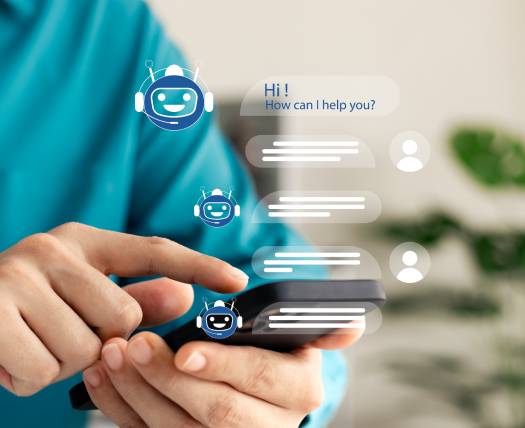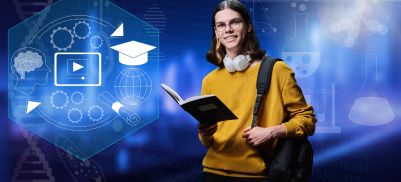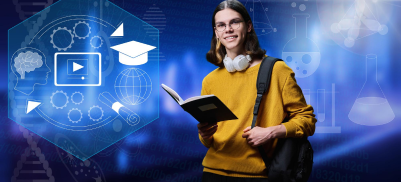5 Use Cases for Artificial Edtech Magazine
Cut through the noise and learn where AI can have a real impact on colleges and universities.
Alexandra Shimalla is a freelance journalist and higher education writer. The concept of artificial intelligence is hardly new, but the full range of opportunities that exist are just being discovered. In the higher education world, colleges and universities are starting to dabble with AI projects, such as chatbots or aids for incoming students. The age of AI is burgeoning, ushering advancements in many fields, so it’s important that any institutions interested in incorporating this technology consider the rules and regulations around it.

Five Ways Higher Education Institutions Use Artificial Intelligence
1. Chatbots

Considering the prevalence of online shopping and the popularity of industry leaders such as Amazon, people are familiar with the concept of online chat features that help customers quickly solve issues. These chatbots are equipped with the latest AI, allowing for faster response time and quicker solutions. And the expectation of communicating with a chatbot to find information easily has started to enter higher education. LEARN MORE: Innovators such as NetApp are guiding higher ed institutions on their AI journeys.
Some colleges and universities are now incorporating these features into their own websites and chatbots, so current and prospective students, curious parents and alumni can easily find the information they’re looking for. Stanford University even has a version of a chatbot that acts as digital flashcards for students, quizzing them on material for upcoming tests. “We’re seeing a lot of benefits out of chatbots,” says Bob Burwell, CTO for state and local government and education at NetApp, which offers toolkits for customers to create these chatbots.
2. Recruitment
In 2018, researchers at Georgia State University tested a theory: Could they increase student enrollment by helping students along the final stretch between acceptance and starting classes? Even after students are accepted to the university, they still need to complete various tasks to finalize enrollment, such as sending a final transcript, completing financial aid paperwork and getting required immunizations. The university sent text message reminders about upcoming application deadlines, using existing data to tailor prompts to each student. It worked: The university was able to decrease the number of students who accepted but didn’t officially enroll by roughly 21%. RELATED: Learn how technology can help higher education confront the enrollment cliff.
3. Student Engagement

The University of Michigan has created MiMaizey, a personalized AI tool in beta testing as of November 2024. MiMaizey answers students’ questions about things such as dining options and transportation and can provide information about clubs and groups on campus. The tool is also connected to the university’s learning management system; because of
this connection, students can ask MiMaizey for study guides for their classes or clarify due dates.
4. Centers of Excellence
Burwell says another use case for AI is within centers of excellence, which universities create to act as beacons for how to use AI to advance research; examples include Emory University’s AI Humanity Initiative and the State University of New York’s AI Plus Institute at the University at Albany. In addition to conducting their own research, these centers also offer opportunities to educate the public and various industries about best practices. The University of Central Florida created its own initiative with the goal of fostering multidisciplinary research and collaboration between faculty from different universities. These institutions are using these centers and initiatives to create a new generation of workers: individuals who are comfortable with AI and understand how the technology can be applied to different settings, such as business or healthcare.

"You need to understand what your data footprint looks like within your environment."Bob Burwell, CTO for State and Local Government and Education, NetApp
5. Identifying Security Risks
Burwell says that colleges and universities are applying AI to their cybersecurity measures. Given the volume of data that universities acquire, Burwell says, they can apply AI to see where attacks might be happening in real time by looking for irregularities and noting how data might be changing. With that information, IT leaders can begin to plan how to prevent cyberattacks and strengthen their existing security.
The Importance of Governance and Policies When Incorporating AI
While the future of artificial intelligence is exciting, the technology is still very much in its infancy. College and universities need to take this time to set a future precedent, Burwell says.
"You need to understand what your data footprint looks like within your environment," says Burwell, referring to the kinds of data that higher education institutions possess, such as highly confidential student and personnel information.
Once the institution has a good idea of what data they're working with, creating and enforcing policies around the data is critical. This governance should address what data can be used and how. Setting up a robust policy can prevent data exposure and avoid serious legal ramifications.
"You have to temper the excitement of AI with the wisdom of knowing that there are a bunch of things in this larger picture that we need to make sure we've got our arms wrapped around first," Burwell says.
These policies should also unpack how far the institution is willing to go regarding the inclusion of AI. For example, when setting parameters, discuss whether students should be allowed to use it as a resource in various classes.
Partnering with a company like NetApp can alleviate some of the stress and headache of undertaking such a large project alone. The experts at NetApp help connect IT and administrative leaders to the other big players in the AI world, such as Microsoft, Amazon Web Services, Google and Cisco.
"The first step is starting the conversation," Burwell says.
AI in Document Verification
Use Cases for AI-Based Identity Document Verification

AI-based ID document verification systems can be beneficial to any industry or vertical that requires end users and customers to prove their identity, including:
Age-restricted content and activities:
AI-based document verification prevents underage and unauthorized individuals from accessing age-restricted and adult-only content and materials both in person and online. Age verification technology can protect minors from accessing potentially harmful substances and ensures compliance with laws and regulations.
Banks and financial institutions:
Banks and financial institutions are some of the biggest targets for fraudsters. In addition to helping them comply with Know Your Customer (KYC) regulations, AI-based identity document verification can stop account takeovers, prevent fraudulent account openings and provide more accurate verification for issuing loans or credit.
Travel:
AI-based tools make traveling smoother and safer for customers. Using AI verification tools to verify passports can automate check-ins at airports and hotels and streamline processes related to getting visa or entry approvals. AI tools can also accurately detect fake IDs and documents, ensuring authenticity and preventing criminals from traveling illegally.
Insurance:
AI in the insurance industry can streamline claims processing and minimize fraud. Faster identity document verification enables policyholders to get faster payouts for their legitimate claims while also quickly detecting claim errors or anomalies that might indicate fraud or identity theft.
Benefits of AI and Machine Learning in Identity Document Verification
When it comes to identity document verification, here are some of the top benefits of AI and machine learning tools:
Helps Drive Efficiency and Accuracy
It’s difficult to spot tampered documents and fake IDs without extensive practice and training. And with fraudsters getting better at creating falsified documents, even proper training may not be enough to stop them. Trying to manually verify documents is risky, time-consuming and expensive.
AI can pick out anomalies and inconsistencies that the human eye might miss, in just a few seconds. AI document authentication enables near-immediate approvals, streamlining internal workflows and providing a better end-user experience. Informed AI uses large data sets to make the verification process faster, more accurate and less biased.
And as an organization scales, AI helps maintain consistency and ensures compliance. Companies can process higher volumes of ID documents without sacrificing quality standards or compromising brand integrity.
Helps Drive More Accessible and Seamless Customer Experiences
For customers, the biggest benefit of AI-based identity document verification is faster processing and approval times. AI-powered systems are dramatically faster than manual methods, meaning customers and users spend less time waiting for access. Customers also can avoid the need to visit physical locations to undergo manual verification processes.
More robust and accurate identity document verification systems can also reduce document requirements and create an easier onboarding experience. AI can get a more accurate read on a customer's identity with fewer documents, reducing the burden of proof and improving accessibility.
AI provides more opportunities for real-time feedback and personalization. Because AI can analyze documents and customer data in just a few seconds, it can quickly detect any errors or missing information, immediately prompting users to make necessary changes to prevent delays and frustrations.
Helps Maintain Compliance
For organizations that need to comply with Know Your Customer (KYC) and Anti-Money Laundering (AML), AI can provide enhanced verifications, screenings and reporting. AI-driven systems match identification documents against reliable databases, helping to perform customer due diligence according to KYC compliance standards.
Ongoing monitoring and watchlist screening can automatically match customer information with growing watchlists and databases as part of AML compliance procedures. Not only does this flag new accounts or high-risk users, it can also proactively check existing customer information for changes to risk status.
AI-powered identity document verification tools can also ensure any sensitive information collected from customers is kept securely and per privacy regulations, as well as properly documented and organized in case of an audit. And as regulations change, AI algorithms can continuously learn and adapt to new or updated standards.
Envisioning the Future: The Transformative Role of AI in Identity Document Verification Solutions
There is no denying that AI is impacting just about every industry — even crime. As fraudsters start to discover new ways to apply advanced technology to get around security measures, organizations need to be prepared to stay one step ahead. The only way to fight AI is with AI.
AI as an aid in educational application processes (Hindustan Times 09 Dec 2024)
By Manish Mohta
Nov 13, 2024 11:22 AM IST
This article is authored by Manish Mohta
The educational industry, like many others, is undergoing considerable transition as a result of advances in Artificial Intelligence (AI). As institutions work to streamline processes and improve user experiences, AI is becoming an essential tool in the application process for educational authorities. AI's impact is complex, ranging from decision-making enhancement to individualised student support, improving efficiency and accessibility for both applicants and schools. It is undergoing a tremendous transition as a result of advances in AI. As institutions work to streamline processes and improve user experiences, AI is becoming an essential tool in the application process for educational authorities. AI's impact is complex, ranging from decision-making enhancement to individualised student support, improving efficiency and accessibility for both applicants and schools.
With increased worldwide student mobility and the rise of online education, educational institutions are managing more applications than ever before. Traditional techniques are time-consuming, labor-intensive, and frequently subject to human error. AI tackles these concerns by automating repetitive processes, freeing up educators' time for more strategic projects.
The use of AI provides a new level of personalisation and reactivity, which is essential in today's competitive academic climate. Students anticipate quick responses and personalised recommendations, and AI technologies are assisting universities in meeting these expectations efficiently.
One of the most significant contributions that AI is bringing to educational institutions is the automation of applicant screening. Traditionally, this procedure entails analysing a large number of documents, including test scores, transcripts, recommendation letters, and personal essays. This task, which was previously burdensome for admission committees, may now be handled quickly by AI-powered systems.
These systems employ Natural Language Processing (NLP) and Machine Learning (ML) algorithms to scan documents, evaluate context, and even assign scores based on predetermined criteria. This not only speeds up the application review process but also lowers bias, ensuring that all applications are evaluated fairly and objectively. AI-driven algorithms can uncover patterns and connections in a candidate's background that might otherwise go overlooked, providing institutions with a more thorough view of each applicant.
AI also helps improve communication between applicants and educational institutions. Many educational websites now contain AI-powered chatbots. These chatbots handle requests, walk students through the application process, and answer frequently asked questions in real-time, 24 hours a day, seven days a week. This constant availability shortens response times, allowing applicants to obtain the information they require without waiting for human interaction.
AI-powered recommendation engines assist prospective students in better navigating their educational options. These algorithms can offer the best programmes, scholarships, and learning paths for a candidate based on their experience, skills, and career objectives. This kind of individualised assistance enables applicants to make educated judgments while also ensuring that educational institutions target the appropriate people for their programmes.
Document verification is one of the issues that institutions confront during the application process. It is vital to ensure the legitimacy of transcripts, certificates, and other documents, but doing so manually can be laborious and time-consuming.
AI solutions can now check the legitimacy of documents utilising optical character recognition (OCR) technology and advanced picture recognition techniques. These systems may cross-check information against internet databases, identify errors, and even detect fraudulent contributions. This not only speeds up the verification process but also ensures that schools uphold strong academic integrity requirements. AI-driven analytics is changing the way educational institutions approach admissions. By evaluating historical application data, AI can provide insights into trends, patterns, and future predictions. This data can be utilised to make better judgments about enrollment, diversity, and programme demand.
If we take an example, AI can estimate which applicants are more likely to succeed in a specific programme based on past cohorts' performance data. Institutions can utilise this data to improve their admissions criteria, ensuring that they select students who are most likely to succeed. Furthermore, AI can assist in balancing class sizes, promote gender or cultural diversity, and predict future student needs, all of which contribute to a more strategic approach to admissions.
AI is also making progress in the evaluation of personal essays and interviews. While human judgment remains important in many domains, AI techniques are being employed to help with the assessment process. NLP algorithms can assess articles for language, structure, and coherence, as well as sentiment and originality. Similarly, AI-powered video interview systems may Determine an applicant's body language, tone of voice, and speech patterns, providing extra information about their fit for a programme.
While these technologies are still in development, they have the potential to supplement human evaluators by adding an extra layer of analysis to provide a comprehensive and fair review of candidates.
As AI becomes more incorporated into the application process, it is critical to address the ethical concerns around its use. Data privacy, algorithmic bias, and the necessity for human oversight are all critical challenges that educational institutions must address. Ensuring openness in how AI systems generate judgments, as well as allowing candidates to appeal or review automated outcomes, are critical steps toward retaining trust and fairness in the admissions process.
Looking ahead, the use of AI in education is expected to grow much further. The future of education promises more innovation, from individualised learning experiences to AI-powered mentorship programmes. As AI evolves, it will surely become an even more helpful tool in refining the application process, making it more efficient, transparent, and accessible to all.
AI is transforming the application process at educational institutions, providing several benefits such as efficiency, personalisation, and fairness. AI helps schools manage the increased demand for higher education by automating routine processes, enhancing decision-making, and delivering real-time communication, while also giving applicants a smoother, more customised experience. As technology advances, its impact on education will only rise, altering the future of academic admissions.